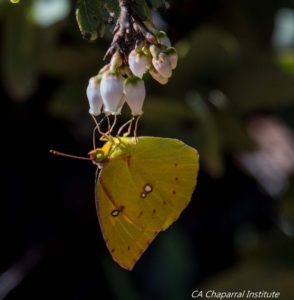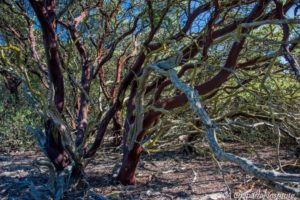
Refugio manzanita and its characteristic urn-shaped flowers. Photo courtesy California Chaparral Institute
Santa Barbara, CA — Today, Los Padres ForestWatch and the California Chaparral Institute submitted a technical request to the U.S. Fish and Wildlife Service to list the Refugio manzanita (Arctostaphylos refugioensis) as endangered under the federal Endangered Species Act of 1973 (ESA). This rare plant can only be found in one place on Earth: along the Santa Ynez Mountain Crest between Gaviota and Santa Ynez Peaks in Santa Barbara County.
Discovered by botanist Roman Gankin in 1966 while he was exploring the Refugio Pass near Gaviota, the Refugio manzanita is an evergreen shrub that can grow up to approximately 15 feet tall. Like other manzanitas, its bark is a striking red color and its flowers are urn-shaped and white or pink. However, the Refugio manzanita, unlike many other manzanita species, only regenerates from seed rather than resprouting from the base of its trunk.

Refugio manzanita seen here with the California dogface butterfly. Photo courtesy California Chaparral Institute
The Refugio manzanita is only found between 1,000 and 3,200 feet in the Santa Ynez Mountains between Gaviota Peak near Highway 101 and Santa Ynez Peak just east of Refugio Road. It has one of the most limited ranges of all manzanita species in the world. “This species is part of the rich and unique natural heritage that makes the Santa Barbara region so special,” said ForestWatch Conservation Director Bryant Baker. “It deserves to be protected.”
Efforts to secure federal protection for this rare plant date all the way back to 1975, when the Smithsonian Institution submitted a request to the U.S. Fish and Wildlife Service to list several species, including the Refugio manzanita, under the newly-enacted ESA. However, due to lack of information on the relatively recently-discovered species at the time, no action was taken. Now, 42 years later, information about the rarity of the species and the many threats it faces have contributed to this new request for endangered species status. In addition, the California Native Plant Society — the foremost authority on native plants in California — considers the Refugio manzanita as “rare, threatened, or endangered in California and elsewhere” as well as “fairly endangered in California.” The U.S. Forest Service has also classified the Refugio manzanita as a “sensitive species” because of its vulnerability and declining population numbers
This manzanita species has been threatened by largescale vegetation clearing projects such as the proposed Gaviota Fuel Break in 2016, which would have cut through the heart of most of the remaining populations of the species had it not been halted by a lawsuit and resulting legal settlement involving ForestWatch, the California Chaparral Institute, and the U.S. Forest Service. Some populations also grow on private land in the Refugio Pass and are at risk of being removed along with their prime habitat due to land development. Furthermore, the spread of invasive species in the Santa Ynez Mountains poses a threat to the Refugio manzanita’s habitat and chance of survival.
Additionally, the increased frequency of wildfires in our region significantly threatens the continued existence of the species. While the Refugio manzanita’s seeds sprout after coming in contact with chemicals released from charred wood and smoke caused by high intensity fires, frequent fire can actually harm the species. When fires occur more than every 30 to 150 years, the seedlings do not have a chance to mature and produce new seed, and the seed bank becomes depleted. This can reduce the size of populations over time, threatening the species’ long-term survival.
“The rare Refugio manzanita is one of the most gorgeous manzanitas in California,” said California Chaparral Institute Director Richard Halsey. “It defines the uniqueness of the Santa Ynez Mountains’ chaparral plant community like no other species. Only found within a narrow band along the coastal ridgeline, the Refugio manzanita is vital to preserving the region’s rich biodiversity.”
The petition details the current populations of the species and how they are at risk of becoming smaller or even extinct. The U.S. Fish and Wildlife Service will now consider our petition for 90 days before issuing a preliminary determination as to whether further review is warranted. If the agency determines that the species may warrant listing as an endangered species, it will enter into a year-long process to decide whether the species will be listed. If the agency does list the species as threatened or endangered, the plant and its habitat would be further protected from harm and would result in the preparation of a recovery plan to ensure that stakeholders take whatever steps they can to safeguard this unique species.
You can read the full petition here.








Comments are closed.